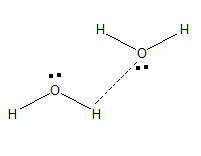
How do water molecules act like "little magnets"?
Answer
474k+ views
Hint: To answer this question we have to understand the structure and the polar nature of water molecules. Water is used as solvent for most of the reactions and it also plays a vital role in living organisms.
Complete answer:
Water is a simple molecule which consists of one oxygen atom bonded to two hydrogen atoms. The chemical formula of water is

The oxygen is more electronegative than hydrogen atom. So, the oxygen atom possesses a partial negative charge and the hydrogen atom possesses positive negative charge. Therefore, water is polar in nature.
Since it is polar in nature the oxygen atom which possesses partial negative (
Same goes with hydrogen, which possesses partial positive charge (
Basically, when a magnet is brought nearer to another magnet it attracts each other. Unlike charges, they attract each other. This is the same that happens in case of Water molecules too.

This is the reason why the water molecule is said to act like a little magnet.
Note:
The polarity of water molecules the point that accounts for its mechanism as a little magnet. Since water molecules can form clusters as illustrated above they are used as solvent for many reactions. If the structure of the water molecule is linear the dipole moment in the water molecule will be 0. Since the water molecule has a bent structure it possesses some dipole moment.
Complete answer:
Water is a simple molecule which consists of one oxygen atom bonded to two hydrogen atoms. The chemical formula of water is

The oxygen is more electronegative than hydrogen atom. So, the oxygen atom possesses a partial negative charge and the hydrogen atom possesses positive negative charge. Therefore, water is polar in nature.
Since it is polar in nature the oxygen atom which possesses partial negative (
Same goes with hydrogen, which possesses partial positive charge (
Basically, when a magnet is brought nearer to another magnet it attracts each other. Unlike charges, they attract each other. This is the same that happens in case of Water molecules too.

This is the reason why the water molecule is said to act like a little magnet.
Note:
The polarity of water molecules the point that accounts for its mechanism as a little magnet. Since water molecules can form clusters as illustrated above they are used as solvent for many reactions. If the structure of the water molecule is linear the dipole moment in the water molecule will be 0. Since the water molecule has a bent structure it possesses some dipole moment.
Latest Vedantu courses for you
Grade 11 Science PCM | CBSE | SCHOOL | English
CBSE (2025-26)
School Full course for CBSE students
₹41,848 per year
Recently Updated Pages
Master Class 11 Economics: Engaging Questions & Answers for Success

Master Class 11 Business Studies: Engaging Questions & Answers for Success

Master Class 11 Accountancy: Engaging Questions & Answers for Success

Master Class 11 English: Engaging Questions & Answers for Success

Master Class 11 Computer Science: Engaging Questions & Answers for Success

Master Class 11 Maths: Engaging Questions & Answers for Success

Trending doubts
State and prove Bernoullis theorem class 11 physics CBSE

1 ton equals to A 100 kg B 1000 kg C 10 kg D 10000 class 11 physics CBSE

State the laws of reflection of light

One Metric ton is equal to kg A 10000 B 1000 C 100 class 11 physics CBSE

Difference Between Prokaryotic Cells and Eukaryotic Cells

1 Quintal is equal to a 110 kg b 10 kg c 100kg d 1000 class 11 physics CBSE




